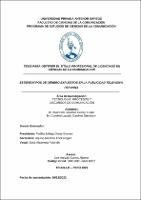| dc.contributor.advisor | Celi Arévalo, Carlos Alberto | |
| dc.contributor.author | Asunción Sánchez, Gresly Yuriko | |
| dc.contributor.author | Cornelio Lavado, Caroline Stephany | |
| dc.creator | Asunción Sánchez, Gresly Yuriko | |
| dc.date.accessioned | 2023-01-10T14:35:09Z | |
| dc.date.available | 2023-01-10T14:35:09Z | |
| dc.date.issued | 2023 | |
| dc.identifier.uri | https://hdl.handle.net/20.500.12759/10042 | |
| dc.description.abstract | La presente investigación tiene como objetivo analizar los estereotipos de género
expuestos en la publicidad televisiva peruana, en el cual se utilizó el diseño de
investigación descriptiva. La población estuvo constituida por 27 spots publicitarios
difundidos en el mes de septiembre y octubre en los canales de televisión América
tv, Latina y Atv. Dentro de ellos seleccionados sus programas con mayor rating,
como: Al fondo hay sitio, La voz, Magaly Tv. Para obtener la recopilación de los datos
se utilizó como instrumento la guía de observación. El análisis de los spots
publicitarios fueron herramientas importantes para lograr los objetivos propuestos,
llegando a la conclusión que los estereotipos de género en la publicidad televisiva
peruana 2022, son creados por la misma sociedad y que fueron reforzados y
perpetuados a lo largo de los años. Los anuncios mas promocionados son alimentos
y artículos domésticos (45%), artículos de belleza (22%), servicios (15%),
medicamentos (11%) y la comunidad LGTBQ (7%), debido a que la publicidad
muestra un modelo distinto a lo que es la realidad. | es_PE |
| dc.description.abstract | The objective of this research is to analyze gender stereotypes exposed in Peruvian
television advertising, in which the descriptive research design was used. The
population consisted of 27 advertising spots broadcast in the month of September
and October on the television channels América tv, Latina and Atv. Among them
selected their programs with the highest rating, such as: Al fondo hay sitio, La voz,
Magaly Tv. To obtain the data collection, the observation guide was used as an
instrument. The analysis of the advertising spots were important tools to achieve the
proposed objectives, reaching the conclusion that gender stereotypes in Peruvian
television advertising 2022 are created by the same society and that they were
reinforced and perpetuated over the years. The most promoted ads are food and
household items (45%), beauty items (22%), services (15%), medicines (11%) and
the LGTBQ community (7%), because the ad shows a model different from what is
reality | en_US |
| dc.description.uri | Tesis | es_PE |
| dc.format | application/pdf | es_PE |
| dc.language.iso | spa | es_PE |
| dc.publisher | Universidad Privada Antenor Orrego | es_PE |
| dc.relation.ispartofseries | T_COM_677 | |
| dc.rights | info:eu-repo/semantics/openAccess | es_PE |
| dc.rights.uri | https://creativecommons.org/licenses/by/4.0/ | es_PE |
| dc.source | Universidad Privada Antenor Orrego | es_PE |
| dc.source | Repositorio Institucional - UPAO | es_PE |
| dc.subject | Estereotipos de Género | es_PE |
| dc.subject | Publicidad Televisiva | es_PE |
| dc.title | Estereotipos de género expuestos en la publicidad televisiva peruana | es_PE |
| dc.type | info:eu-repo/semantics/bachelorThesis | es_PE |
| thesis.degree.level | Título Profesional | es_PE |
| thesis.degree.grantor | Universidad Privada Antenor Orrego. Facultad de Ciencias de la Comunicación | es_PE |
| thesis.degree.name | Licenciado en Ciencias de la Comunicación | es_PE |
| thesis.degree.discipline | Ciencias de la Comunicación | es_PE |
| dc.subject.ocde | https://purl.org/pe-repo/ocde/ford#5.08.00 | es_PE |
| renati.advisor.orcid | https://orcid.org/0000-0001-6646-8202 | es_PE |
| renati.author.dni | 60038807 | |
| renati.author.dni | 70477063 | |
| renati.advisor.dni | 18030045 | |
| renati.type | https://purl.org/pe-repo/renati/type#tesis | es_PE |
| renati.level | https://purl.org/pe-repo/renati/level#tituloProfesional | es_PE |
| renati.discipline | 322999 | es_PE |
| renati.juror | Padilla Zúñiga, Dante Giovani | |
| renati.juror | Aquino Montoro, Erick Rogert | |
| renati.juror | Sosa Alzamora, Rolando | |
| dc.publisher.country | PE | es_PE |


